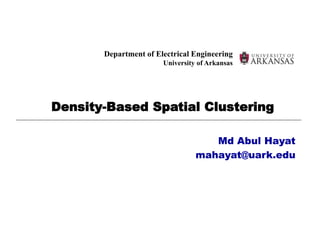
Fa18_P2.pptx
- 1. Department of Electrical Engineering University of Arkansas Density-Based Spatial Clustering Md Abul Hayat mahayat@uark.edu
- 2. OUTLINE • Introduction • k-means clustering • DBSCAN – Definitions – Advantages – Limitations • OPTICS – Definitions – Advantages – Limitations
- 3. K-means Clustering – An Unsupervised approach for partitioning a data set into K distinct, non- overlapping clusters. [Lloyd, 1982] – We must first specify the desired number of clusters ‘K’. – Then the K-means algorithm will assign each observation to exactly one of the K clusters. – The optimization problem that defines K-means clustering, – The problem is computationally NP –hard.
- 4. K-means : Algorithm • Lloyd’s Algorithm – Mathematically, this is partitioning the observations according to the Voronoi diagram generated by the means.
- 5. How Lloyd’s Algorithm Work
- 6. Problems with K-means – K-means partition the space in Voronoi cells and they are convex in nature. – Thus k-means does not perform good when we have non-convex clusters – We have to provide the number of clusters beforehand. – Sometimes, we want to find out the intrinsic number of clusters within the dataset. – No way of handling noise separately.
- 7. Problems with K-means • Non-convex Clusters • When we do not know the number of clusters. • To solve these issues, density based clustering was introduced.
- 8. DBSCAN • Density-Based Spatial Clustering of Applications with Noise (DBSCAN) • Inventors: Martin Ester, Hans-Peter Kriegel, Jörg Sander, and Xiaowei Xu. • Paper : “A Density-Based Algorithm for Discovering Clusters in Large Spatial Databases with Noise” • Presented at the International Conference of Knowledge Discovery and Data Mining (KDD) in 1996. KDD is a SIG of ACM. • Citations: 13,293 (till 11/04/2018) • The ‘2014 Test of Time’ award recognized DBSCAN as an influential contributions to SIGKDD that have withstood the test of time. • This is an unsupervised algorithm.
- 9. Definitions – The shape of a neighborhood is determined by the choice of a distance measure between two points p and q, denoted by d(p,q). – For instance, when using the Manhattan distance in 2D space, the shape of the neighborhood is rectangular. – For the purpose of proper visualization, all examples will be in 2D space using the Euclidean distance.
- 10. Distance Measures – If we have two points – Minkowski Distance:
- 11. Definitions •
- 13. Definitions
- 14. Definitions • Introduction • [ Link: Funny Visualization ]
- 16. DCSCAN : Examples • Resistant to Noise (unlike k-means) • Can handle clusters of different shapes and sizes Original Data After DBSCAN
- 17. DBSCAN Limitations • Introduction (MinPts=4, Eps=9.92). (MinPts=4, Eps=9.75) Original Data • Cannot handle varying densities. • Sensitive to parameter selection.
- 18. Heuristics for Choosing DBSCAN Parameters – Let d be the distance of a point p to its k-th nearest neighbor, then the d- neighborhood of p contains exactly k+1 points for almost all points p. – For a given k we define a function k-dist (= d) from the database D to the real numbers, mapping each point to the distance from its k-th nearest neighbor. – When sorting the points of the database in descending order of their k-dist values, the graph of this function gives some hints concerning the density distribution in the database. – If we choose an arbitrary point p, set the parameter Eps to k-dist(p) and set the parameter MinPts to k, all points with an equal or smaller k-dist value will be core points. – All points with a higher k-dist value ( left of the threshold) are considered to be noise, all other points (right of the threshold) are assigned to some cluster
- 19. DBSCAN : Parameter Selection – The easier-to-set parameter of DBSCAN is the minPts parameter. – Sander et al. suggest setting it to twice the dataset dimensionality, i.e., minPts = 2 · dim. – Ester et al. provide a heuristic for choosing the ε parameter based on the distance to the fourth nearest neighbor (for two/dimensional data). – In Generalized DBSCAN, Sander et al. suggested using the (2 · dim - 1) nearest neighbors and minPts = 2 · dim
- 20. OPTICS • Ordering Points To Identify the Clustering Structure (OPTICS) – Inventors: (1999) Mihael Ankerst, Markus M. Breunig, Hans-Peter Kriegel, Jörg Sander – Paper: “OPTICS: Ordering Points To Identify the Clustering Structure” – OPTICS requires the same ε and minPts parameters as DBSCAN, however, the ε parameter is theoretically unnecessary and is only used for the practical purpose of reducing the runtime complexity of the algorithm. – While DBSCAN may be thought of as a clustering algorithm, searching for natural groups in data, OPTICS is an augmented ordering algorithm. – In OPTICS, we have to introduce two more definitions. – Here, we just fix the minPts parameter and we can get the insight of the underlying clusters using a plot called ‘Reachability Plot’.
- 21. OPTICS : Definitions • Introduction
- 22. OPTICS : Definitions • Introduction ε = Generating Distance ε’ = Core Distance
- 24. Reachability Graph : Toy Example
- 25. Reachability Graph : Toy Example • Introduction
- 26. Reachability Graph : Toy Example • Introduction
- 27. Reachability Graph : Toy Example • Introduction
- 28. Reachability Graph : Toy Example • Introduction
- 29. Reachability Graph : Toy Example • Introduction
- 30. Reachability Graph : Toy Example • Introduction
- 31. R Package & Examples • dbscan: Density Based Clustering of Applications with Noise (DBSCAN) and Related Algorithms – Published: May 19, 2018 – From the order discovered by OPTICS, two ways to group points into clusters was discussed
- 32. ξ-Cluster
- 34. ξ-Cluster
- 36. Conclusion • Reachability plots are helpful to determine the number of clusters. • Can be applied to find clusters in high dim-data (like image). • DBSCAN and OPTICS, both are unsupervised techniques.
- 37. Questions?